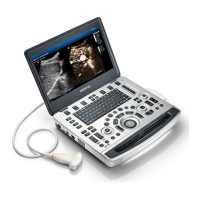6 Image Acquisition
Operator’s Manual 6 - 23
– Strain rate: speed of the deformation, as myocardial variability will result in velocity
gradient, strain rate is used commonly to evaluate how fast the tissue is deforming.
Perform the following procedure:
1. Scan the image with the moves of myocardium on, freeze the image and select the scan scope,
or open the image which includes the myocardium moves already.
NOTE:
• The current image (in frozen state) and the saved image can be used in the quantitative
analysis.
1 TDI review Sampling area: indicates the sampling position of the curve. The
sampling lines are marked with color numbers. It can mark 8 ROIs at
most.
2 2D grey image
review
• Use the trackball; the images in TDI review window and 2D review
window are reviewed synchronously, since the two images are frozen
at the same time.
• ROI movement is linked between the TDI (Tissue Doppler Imaging)
review window and the 2D imaging reviewing window.
3 Display analysis
curve
• Y-axis represents the velocity (unit: cm/s) [in strain-time curve, Y-
axis represents the strain (%); in strain rate-time curve, Y-axis
represents the strain rate (unit: 1/s)].
• X-axis represents time (s);
• Frame mark: a white straight line perpendicular to the X-axis, and
can be moved left and right by using the trackball.
• Click the check box in front of the ROI to display or hide the analysis
curve.
• You can get the current X/Y axis value by moving the cursor onto
one point on the curve; and if you press <Set> at this time, the frame
marker will move to the spot.
4 ECG display area /
2
1
3
4

